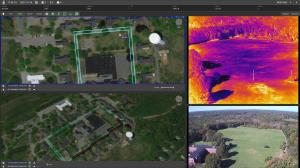Kongsberg Geospatial, SFL Scientific Introduce AI-Driven Technology to Identify Chemical Threats Using Drones
Kongsberg Geospatial, and SFL Scientific to demonstrate how AI is being used to develop unmanned systems for complex tasks including CBRNE threat identification
The two companies will be showing video captured during live trials of the system in an upcoming online seminar hosted by the Association for Unmanned Vehicle Systems International (AUVSI).
Kongsberg Geospatial, along with its partner SFL Scientific, will demonstrate how a medium-sized commercial drone carrying a sensor package can autonomously recognize chemical threats, identifying and ultimately displaying invisible hazardous plumes, in real-time.
This implementation fuses data from a visual, thermal, multichannel chemical sensor (the FLIR MUVE C360), with environmental, and location data using a dedicated AI processor (the NVIDIA Jetson). The system leverages SFL custom bleeding-edge Generative Adversarial Networks (GANs) and Graph Deep Learning models to autonomously identify threats.
The system also includes sub-systems for route planning to access and address any threats the system detects.
The resulting sensor picture, including threat identification and route suggestions from the AI systems, will be displayed in an integrated picture within Kongsberg Geospatial’s IRIS UxS ground control station (GCS) system. IRIS is an airspace situational awareness system developed to provide drone operators with the necessary situational awareness to safely operate one or more drones Beyond Visual Line-of-Sight (BVLOS).
The two companies hope to demonstrate how AI and machine-learning systems can be evolved to allow drones to perform complex, mission-critical tasks in an increasingly autonomous manner.
“The rapid identification of chemical and visual threats is crucial in a variety of civilian and federal missions”, explained Michael Segala, PHD, CEO of SFL Scientific. “Next-generation devices will be integrated with the capability to autonomously identify, locate, and help prioritize decisions in the detection of threats, anomalous activity, and other key indicators to support the safety and effectiveness of individuals working as first responders in potentially hazardous situations.”
Dr. Segala will describe how this pioneering work by SFL Scientific leverages next-gen AI technology to help interpret raw sensor data in real-time.
Rex Hayes, Director of Unmanned Systems for Kongsberg Geospatial will provide information on how the company’s IRIS system will be used to integrate the sensor data, and resulting AI interpretation of that data - including route planning – into a single, comprehensive picture to help reduce the cognitive load on UAS operators.
“IRIS helps UAS operators maintain a common operational picture (COP) of the air environment, while decreasing the cognitive load from interpreting separate and multiple sensor data. Leveraging AI to increase the autonomy of the system allows the operator to remain focused on their mission and be more effective overall”, said Mr. Hayes.
The presentation will feature an overview of how the system works, together with video clips of the system detecting chemical plumes in a series of recent controlled trials.
The online seminar will be hosted on Wednesday, November 10th, 2021 at 3:00pm EDT by AUVSI, and a link for registration is available below.
https://www.auvsi.org/events/webinars/ai-based-uav-decision-algorithm-cbrne-threat-identification-route-planning-and
ENDS ###
About Kongsberg Geospatial: Based in Ottawa, Canada, Kongsberg Geospatial (https://kongsberggeospatial.com) creates precision real-time software for air traffic control and UxS and situational awareness. The Company’s products are primarily deployed in solutions for air-traffic control, Command and Control, and air defense. Over nearly three decades of providing dependable performance under extreme conditions, Kongsberg Geospatial has become the leading geospatial technology provider for mission-critical applications where lives are on the line. Kongsberg Geospatial is a subsidiary of Kongsberg Defence Systems.
Media contact: 1-800-267-2626 or reach us by email at info@kongsberggeospatial.com
About SFL Scientific: Based in Boston, MA, SFL Scientific (https://sflscientific.com) provides data science consulting and AI engineering services. Their team of data scientists, AI engineers, technical consultants, and R&D experts provide strategy and AI services across industries with custom computer vision, NLP, time-series, deep learning, and software solutions to enable strategic insights and operational capabilities.
Image: Kongsberg Geospatial and SFL Scientific have announced an AI-enabled system to detect chemical and biological threats from the air using drones, and display potential threats and suggested routes to the operator in real-time.
Christopher Ivey
Kongsberg Geospatial
+1 6132715501
email us here
Visit us on social media:
Twitter
LinkedIn
Legal Disclaimer:
EIN Presswire provides this news content "as is" without warranty of any kind. We do not accept any responsibility or liability for the accuracy, content, images, videos, licenses, completeness, legality, or reliability of the information contained in this article. If you have any complaints or copyright issues related to this article, kindly contact the author above.

